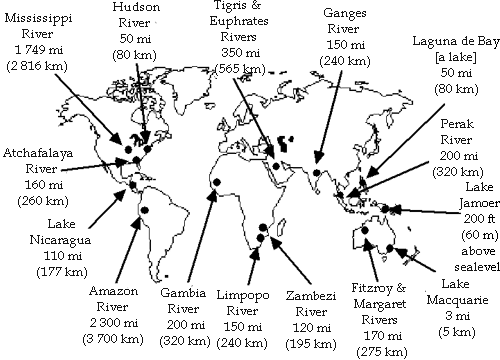Fresh Waters: Unexpected Haunts
Bull Shark
Just the Facts:
Size:
Reproduction:
Diet:
Habitat: Intertidal, Estuaries, Sandy Plains, Rocky Reefs, Coral Reefs, Fresh Waters Depth: from far up freshwater rivers (up to 2,300 mi or 3,700 km in the Peruvian Amazon) and from the intertidal to a depth of at least 500 ft (152 m) Distribution: Central Pacific, Tropical Eastern Pacific, Caribbean, Amazonian, Eastern North Atlantic/Mediterranean, West African, Southern African, Madagascaran, Arabian, Indian, South East Asian, Western Australian, Southeast Australian/New Zealand, Northern Australian |
It has been joked that the only guaranteed way to avoid shark attack is a life-sentence at Leavenworth. No dangerous shark (of the piscine variety, at least) has thus far been reported from Kansas. But, astonishing as it may seem, the large, toothy, and definitely dangerous Bull Shark (Carcharhinus leucas) has been reported as much as 2,360 miles (3,800 kilometres) up the Mississippi River — near the community of Alton, Illinois. Even more remarkable, the Bull Shark has been recorded 2,610 miles (4,200 kilometres) up the Amazon River — actually in the foothills of the Peruvian Andes, which must surely rank as one of the most unexpected places to find a shark.
To date, Bull Sharks have been reported in many tropical rivers and lakes in Australia, New Guinea, the Philippines, Asia, and Africa as well as in North, South, and Central America. At each of these locations, the Bull Shark was thought to be a different species, each known by a separate alias. Thus, among numerous others, we had the Zambezi Shark, the Ganges River Shark, the Fitzroy Creek Whaler, Van Rooyen’s Shark, and the Lake Nicaragua Shark. Eventually, taxonomists were able to compare the many descriptions and some of the actual type specimens (which serve as official representatives of their species), concluding that all of these nominal species were actually one and the same, our old friend the Bull Shark. Although the Lake Nicaragua Shark was declared synonymous with the Bull Shark in 1961, it wasn’t until ten years later that it was demonstrated that this supposedly land-locked population wasn’t.
Lake Nicaragua empties into the Caribbean Sea via the Rio San Juan, which is punctuated by eight sets of rapids. It had been known since 1966 that the full length of the Rio San Juan is navigable by barges with drafts of 3 feet (1 metre) or less and that Bull Sharks are found throughout the river. During 1968 and 1969, a team from the University of Nebraska tagged more than 2,200 Bull Sharks in Lake Nicaragua, at the mouth of the Rio San Juan, and at the mouths of several nearby rivers. About 10% of the tags were returned from recaptured sharks, indicating that they do, in fact, traverse both up and down the 118 miles (190 kilometres) of river separating Lake Nicaragua and the Caribbean Sea, taking as little as 7 to 11 days to complete the trip. Therefore, the system of rapids that provides no significant challenges to the passage of barges also does not impede Bull Sharks from freely moving between Lake Nicaragua and the Caribbean Sea.
But how do Bull Sharks handle the physiological stresses imposed by moving between full-strength salt water and completely fresh water? Extensive physiological studies carried out by the University of Nebraska team determined relative blood serum concentrations of salts and urea as well as rate of urine production in Bull Sharks from both Lake Nicaragua and along the western shore of the Caribbean. Results indicate that blood and other body fluids sampled from Bull Sharks caught in Lake Nicaragua contains 20% less sodium and chlorine ions and less than half the urea than that of their Caribbean counterparts. Further, the urine excreted by lake-dwelling Bull Sharks is very dilute and its flow rate more than 20 times that of those caught in the sea. Similar physiological parameters have been reported from Bull Sharks in other fresh- or brackish-water systems. Thus, Bull Sharks fight the osmotic imbalance between their internal ‘saltiness’ and fully fresh water by greatly reducing the concentration of solutes in their blood and other body fluids. But, rather than eliminate the osmotic imbalance, this approach only reduces it, requiring a greatly increased production of highly dilute urine.

Selected freshwater locations where Bull Sharks have been recorded
Such a high urine flow rate is energetically very demanding. Further research by the University of Nebraska team indicated that Lake Nicaragua Bull Sharks do not reproduce in the lake. Instead, both mating and the bearing of pups appears to take place in estuarine waters along the western coast of the Caribbean Sea. This may be because Bull Shark neonates lack the energy stores necessary for their kidneys to continually process the enormous quantities of water demanded in a fully freshwater environment. Yet coastal estuaries provide rich feeding and relative safety from predators large and powerful enough to consume newborn Bull Sharks. Since shark mating typically takes place shortly after pupping, it seems likely that both occur in the same or nearby shallow, salinity-reduced coastal waters. Young Bull Sharks remain in such waters for several years, expanding their geographical and salinity ranges as they grow.
In addition to being able to tolerate a wide range of salinities, Bull Sharks are able to exploit a remarkably diverse diet. In Lake Nicaragua, the young feed mostly on small teleost fishes while adults feed primarily on large teleosts such as the Tarpon (Megalops atlanticus), but also take smaller Bull Sharks, sawfishes, turtles, birds such as tyrant flycatchers (family Tyrannidae), and even mammals — including the usually strictly arboreal sloth (Bradypodidae). In South African lakes and rivers, Bull Sharks are mostly immatures and have relatively low prey diversity available to them. But the adults of this species are wide-ranging in southern African coastal waters, taking a very broad prey spectrum, including marine and freshwater crabs, shrimps, hermit crabs, mantis shrimps, squids, marine snails, sea urchins, a wide variety of teleosts, sharks and rays, sea turtles, birds, dolphins, whale offal, and terrestrial mammals such as antelopes, cattle, dogs, rats, and (very occasionally) people. In the Limpopo River in southern Mozambique, Bull Sharks have been known to attack young Hippos (Hippopotamus amphibius). Throughout their range, Bull Sharks are important predators on other elasmobranchs, particularly on stingrays and young sharks of other species in inshore nursery grounds. For example, in North American waters, it seems to have a particular fondness for young Sandbar Sharks (Carcharhinus plumbeus). If only one conclusion can be drawn from analysis of the Bull Shark’s gastronomic eclecticism it must be that this species is an extremely opportunistic feeder, probably second only to the Tiger Shark (Galeocerdo cuvier) in the sheer variety of its diet.

The euryphagous Bull Shark probably owes its varied diet to numerous physical attributes. First and foremost, it has large and very heavily calcified jaws that are armed with broadly triangular, serrated teeth. This dental equipment enables the Bull Shark to take large prey and to carve bite-sized hunks from even the largest and toughest of food items. Second, it is a very solidly-built, stout-bodied shark with a heavily muscled ‘nape’ that becomes even more pronounced in older individuals. This overall stockiness grants the Bull Shark the muscular strength and sheer body mass needed to overpower even very large and strong prey. And third, it apparently compensates for its small eyes and often turbid haunts by relying on its other senses, particularly its keen hearing and scent-tracking abilities. Together, these attributes combine to make the Bull Shark a formidable and adaptable predator.
As impressive as are its osmoregulatory and predatory feats, the Bull Shark shares its freshwater realm with several other shark species. On the Indian subcontinent, the Bull Shark shares the Hooghley and Ganges river systems with the Ganges Shark (Glyphis gangeticus), while it shares the rivers and certain lakes of Borneo, southeastern New Guinea, and northern Queensland, Australia, with one or more species of so-called “spear-tooth shark” (Glyphis spp.), at least one of which is in the process of being formally described and named as I write this. The Ganges and spear-tooth sharks are quite poorly known, but seem to be more thoroughly adapted than the Bull Shark to long-term living in freshwater — and may, in fact, be restricted to this habitat type. They have broadly triangular and serrated upper teeth, much like those of the Bull Shark, but their lower teeth are longer and more slender, with tips expanded laterally like spear tips. This suggests that these sharks have a diet that is probably more strictly piscivorous than that of the gastronomically adventurous Bull Shark.
Intriguingly, the eyes of the Ganges Shark — while minute — are oriented upward in their sockets. In contrast, those of the Bull Shark are oriented laterally and somewhat downward. This disparity implies that the Ganges Shark may swim close to the bottom and locate a significant portion of its prey by its silhouette on the surface, while the Bull Shark may find much of its food on or near the bottom. Thus, where they occur together, the Bull and Ganges Shark may be able to divide the food resources of freshwater rivers by hunting for prey at different layers of the water column.
Unlike the river sharks of the genus Glyphis, the Bull Shark does not complete its entire life cycle in fresh water. But because of its predatory attributes and ability to tolerate a wide range of salinities, it is able to exploit virtually any food source it encounters in the sea, in estuaries, and far up freshwater rivers. Heavy rains often wash carrion down-river, which may lure Bull Sharks into freshwater systems. Because a great many people in tropical climes live along the coast, the shores of lakes, or the banks of rivers, the Bull Shark may come into contact with humans more frequently than any other large shark. Given its formidable size and dentition, the Bull Shark may be the most dangerous of all shark species. However, it is becoming painfully clear that freshwater habitats are very sensitive to pollution and other ecological stresses imposed by human habitation. Thus we may prove to be an even greater danger to Bull Sharks than vice versa.
Bull Shark Bibliography
More on:
Why Most Sharks Live in
Salt Water
Freshwater Sharks and Rays |
River Sharks

